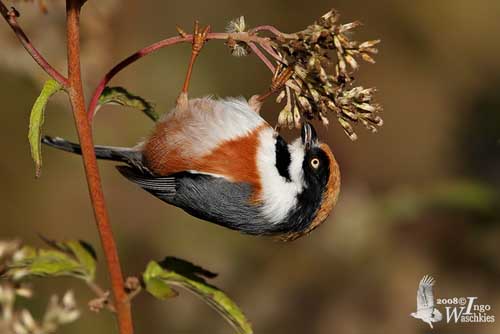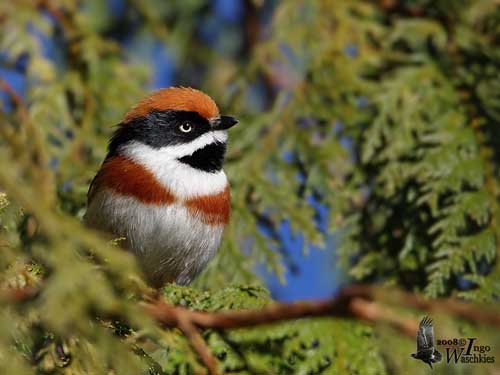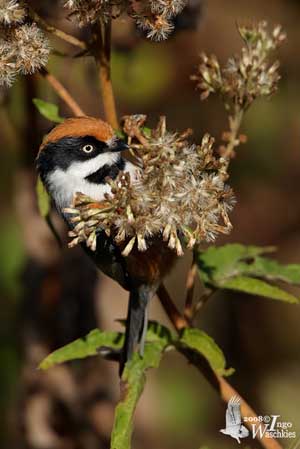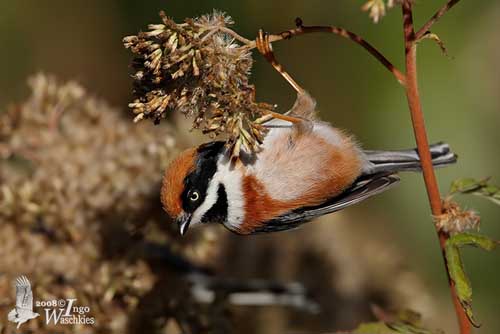
Fr: Mésange à tête rousse
All : Schwarzkehl-Schwanzmeise
Esp: Mito Gorjinegro
Ital: Codibugnolo testarossa
Nd: Roodkopstaartmees
Sd: Rödhättad stjärtmes
Photographer:
Ingo Waschkies
Bird Photography
Text by Nicole Bouglouan
Sources:
HANDBOOK OF THE BIRDS OF THE WORLD Vol 13 by Josep del Hoyo-Andrew Elliot-Jordi Sargatal - Lynx Edicions – ISBN: 9788496553453
A Field Guide to the Birds of South-East Asia by Craig Robson. New Holland Publishers. ISBN: 9781780090498
BirdLife International (BirdLife International)
Wikipedia, the free encyclopaedia
Black-throated Tit
Aegithalos concinnus
Passeriforme Order – Aegithalidae Family
BIOMETRICS:
Length: 10-11 cm
Weight: 4-9 g
DESCRIPTION:
Compared to the related Long-tailed Tit (Aegithalos caudatus), the Black-throated Tit has shorter tail and more contrasted colours. This is a small passerine.
The adult of nominate race has blue-grey upperparts. The rump is tinged brownish-ochre. The dark flight feathers are broadly fringed grey. The medium-long tail is blackish-brown with grey feathers’ edges. The outermost rectrices are tipped white.
On the underparts, chin and neck sides are white, whereas throat is black with white band across the lower throat, bordered by narrow cinnamon rufous breast band. Flanks are rufous chestnut. Rest of underparts are white but belly and vent may be pale pinkish-buff in worn plumage.
On the head, forehead, crown and nape are bright cinnamon. A conspicuous black mask includes lores and broad band extending backwards through the eyes to nape sides.
The short bill is black. The eyes are yellow-white. Legs and feet are brownish orange.

Both sexes are similar. The juvenile is duller than adults, with variable spotted or streaked gorget, and washed buff underparts.
We can find six subspecies which differ in plumage pattern and tone.
VOICE: SOUNDS BY XENO-CANTO
The Black-throated Tit is very vocal. Contact calls are high-pitched “si-si-si-si…” or “si-si-si-si-li-u”. A thin “psip psip” is also heard.
When excited, it gives a short, squeaky “sup” extending to short rattling “churr trrrt trrrt”.
The song is a twittering “tir-ir-ir-ir-ir” often repeated and interspersed with some single chirping notes, but also with high-pitched “tur-r-r-tait-yeat-yeat-yeat”.
These birds are highly gregarious and usually occur in flocks. They need continuous contact calls between them.
HABITAT:
The Black-throated Tit frequents the edges of deciduous evergreen and mixed deciduous and pine forests, and secondary growths. This species is visible between 900 and 2600 metres of elevation.
RANGE:
The Black-throated Tit is found in NE Pakistan in the foothills of the Himalayas, in northern India, Nepal, Bhutan, southern Tibet, C and S China and Taiwan.
This species is mostly resident in its range, only performing erratic and limited altitudinal movements.

BEHAVIOUR:
The Black-throated Tit feeds mainly on insects, but also takes small seeds and berries. This gregarious bird forages in flocks of up to 40 birds, in middle and lower storeys. They may join mixed-species feeding groups.
The behaviour of this species during the breeding season is poorly known, but we can suggest that they could be very similar to those of Long-tailed Tit.
The male performs a butterfly-like jerky flight at 5-6 metres above the ground, and dives vertically downwards. Another display shows both sexes perched close to each other. The male sings for the female while its wings are vibrating sometimes.
They roost communally on branches.
FLIGHT:
The Black-throated Tit is very agile and active.

REPRODUCTION:
The Black-throated Tit breeds from late February-early March to June, but the season may vary according to the range.
This species breeds sometimes co-operatively with helpers performing the nesting duties. There is only one brood per season.
The nest is built by both adults, but mainly by female, and the building lasts between 10 and 15 days.
This is an oval structure with an entrance hole near the top on one side. It is made with several plant materials such as moss, lichen, rootlets, bark scraps and hair, bound together with spider webs. The inner cup is lined with soft materials such as feathers and plant down or wool. The nest is placed about 3 metres above the ground in fork or built around several twigs in small tree or bush.
The female lays 3-8 white or pale pink eggs, finely spotted reddish. The incubation lasts about two weeks by both sexes, but mainly by female although the male roosts in the nest. Both parents feed the chicks which leave the nest 14 days after hatching. They still depend on parents for 10 days after fledging.

DIET:
The Black-throated Tit feeds on insects and spiders, and also takes small seeds and berries.
PROTECTION / THREATS / STATUS:
The Black-throated Tit is usually common or fairly common, and even locally abundant.
This species is not currently threatened.